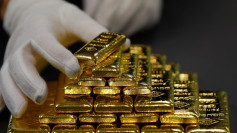Debt negotiation abruptly ceased, causing a downturn in U.S. stocks. Jerome Powell, Chairman of the Federal Reserve, hinted at a pause in rate hikes next month, sparking a surge in U.S. Treasury yields. The Chinese yuan made a strong comeback, rising over 600 points during the day.
Following Powell's remarks, the decline in U.S. stocks narrowed, and U.S. Treasury yields plummeted. The yield on two-year notes fell more than 10 basis points, still marking its largest weekly increase in nearly a year. The U.S. Dollar Index fell from its nearly seven-week high, but still rose for two consecutive weeks. U.S. stocks fell, but the NASDAQ continued its four-week rise, and the S&P 500 recorded its largest weekly gain in seven weeks. Regional Bank ETFs fell, but marked their largest weekly gain in two years, and Western Pacific rose more than 20% in a week. Gold emerged from its seven-week low, still marking its largest weekly decline in three months. Crude oil fell for two consecutive days, but ended its four-week decline. U.S. natural gas fell, but rose 14% for the week, marking its largest weekly gain in two months.
On Thursday, optimism emerged when Republican leader in the House of Representatives, Kevin McCarthy, suggested that a debt limit deal could be reached over the weekend. However, the outlook for debt limit talks darkened on Friday.
According to media reports, Republican negotiators suddenly left a meeting with White House representatives on Friday morning. One Republican representative accused the White House of being unreasonable, stating that negotiations had "paused," and it was unclear if there would be further talks later or over the weekend. When news of the abrupt halt in negotiations emerged, all three major U.S. stock indexes turned lower.
However, Federal Reserve Chairman Powell conveyed a dovish signal that could pause interest rate hikes. Powell suggested that pressures in the banking industry could affect the Fed's interest rate trajectory. If a tightening credit environment stemming from a banking crisis slows the economy, the Fed may not need to raise rates to the initially expected level. Unlike his usual stance that the risk of hiking too little is greater than that of hiking too much, this time he said that the risks of hiking too much and too little are becoming more balanced. Analysts said that Powell has sent a clear signal of openness to pausing rate hikes next month.
After Powell's speech, the decline in U.S. stocks narrowed; U.S. Treasury prices jumped, yields plunged, and the yield on the rate-sensitive two-year U.S. Treasury quickly fell from its two-month high set before his speech, falling more than 10 basis points from its high; the U.S. Dollar Index refreshed its daily low, falling away from the high set on Thursday since the end of March.
The fluctuation on Friday did not change the trend of U.S. stocks, bonds, and exchange rates this week. Thanks to the sharp rise after the first light of the debt ceiling on Wednesday and Thursday, the main stock index retained the weekly rise. Because of the continuous rise in the first four days, the yield on U.S. Treasury bonds still rose for the week, and the two-year yield had its largest increase in nearly a year. The U.S. Dollar Index continued to rise, but failed to refresh its largest weekly increase in three months.
As the U.S. dollar retreats, non-U.S. currencies are rebounding, with the offshore yuan performing particularly strongly. The Chinese Foreign Exchange Market Guidance Committee proposed during its Friday meeting that in the next phase, the People's Bank of China and the Foreign Exchange Bureau will enhance expectation guidance, correct pro-cyclical and unilateral behavior when necessary, and curb speculative trading. Self-discipline mechanism member units should consciously maintain the basic stability of the foreign exchange market and resolutely suppress large fluctuations in exchange rates. The offshore yuan then quickly refreshed its daily high, rebounding by more than 600 points from the lows set earlier on Friday, a position unseen since early December of the previous year.
In commodities, as the U.S. dollar and U.S. bond yields fell, gold rebounded slightly. However, as risk aversion cooled off after positive news on the debt ceiling in the previous days, the weekly downward trend in gold prices remained unchanged, marking its worst performance in over three months. With uncertain prospects for debt negotiations, international oil prices failed to rebound successfully. Despite a big rise on Wednesday, they managed to end a month-long losing streak. U.S. natural gas prices fell slightly, but bounced back sharply due to concerns about supply prospects triggered by U.S. inventory data released on Thursday. This marked the first double-digit weekly rise in over two months.
European natural gas performance diverged from that of the U.S., despite a slight rebound on Friday, bidding farewell to its near two-year low. The market continued its decline from the end of March. Analysts said that after European continental natural gas fell below 30 euros on Thursday, it seemed to have found temporary support. Weak demand and increasing inventory have been weighing on gas prices. Weather forecasts also indicated that temperatures in central and northern Europe will be higher next week. Unusually high temperatures are expected in cities such as Berlin and Helsinki, exacerbating recent downward pressure on gas prices.
U.S. stocks retreated, with the Nasdaq continuing its four-week rally and the S&P recording its highest weekly gain in seven weeks. The Regional Bank ETF recorded its best weekly performance in two and a half years. All three major U.S. stock indices opened higher. In the morning, when the daily high was refreshed, the Dow Jones Industrial Average rose nearly 117 points, up more than 0.3%. The S&P 500 index rose nearly 0.4%. The Nasdaq Composite Index rose more than 0.3% at the opening, but fell twice briefly about half an hour after the opening. After news broke of a sudden halt in debt negotiations, all three indices fell. At the beginning of midday trading, when the daily low was refreshed, the Dow fell nearly 200 points, down nearly 0.6%, the Nasdaq fell nearly 0.5%, and the S&P fell more than 0.4%. Losses narrowed thereafter.
In the end, all three major indices fell collectively for the second time this week, after Tuesday, ending a two-day rally. The Dow, which had refreshed its high since May 9 on Thursday, closed down 109.28 points, a drop of 0.33%, to 33,426.63 points. The Nasdaq fell 0.24% to close at 12,657.9 points, hitting new highs since last August for two consecutive days and three days this week. The S&P, which had reached a new closing high since August 25 of last year on Thursday, fell 0.14% to close at 4,191.98 points.
The small-cap, value-oriented Russell 2000 index fell 0.62%, breaking its two-day rally and reaching the highest level since April 24. The tech-heavy Nasdaq 100 index dropped 0.22%, falling from its highest level since April last year after four consecutive days of gains.
Despite the drop on Friday, the major stock indexes still posted gains for the week, with the Nasdaq up 3.04%, and the Nasdaq 100 up 3.47%, both hitting the largest weekly increases since March 17, and gaining for four consecutive weeks. The S&P 500 was up 1.82%, marking its biggest weekly rise since March 31. The Dow Jones increased 0.38%, ending two consecutive weeks of losses. The Russell 2000, which fell for three consecutive weeks, was up 1.89%.
Among the S&P 500 sectors, only four were up on Friday, with the energy sector up more than 0.7%, healthcare up nearly 0.5%, materials up nearly 0.3%, and consumer staples up slightly. Of the seven sectors that fell, the consumer discretionary sector, where Nike is located, fell over 0.8%. The financial sector, home to banking stocks, and the communication services sector, where Netflix and Meta are located, fell nearly 0.5%. The other sectors fell less than 0.3%.
All seven sectors posted gains for the week, led by the IT sector, where semiconductor stocks are located, up about 4.2%. Communication services increased by more than 3%, and both consumer discretionary and financial sectors were up more than 2%. Among the four sectors that fell, utilities fell more than 4%, real estate fell more than 2%, consumer staples fell over 1%, and healthcare fell nearly 0.7%.
Bank stocks overall fell back on Friday, with regional banks falling more. The KBW Bank Index (BKX) fell over 1.8% in the morning and closed down nearly 1%. The KBW Nasdaq Regional Banking Index (KRX) dropped over 3% and closed down 2.2%. The regional bank ETF, the SPDR S&P Regional Banking ETF (KRE), fell 3.5% in the morning and closed down 1.8%, all dropping from highs since May 1. However, all had strong gains for the week, up 5.8%, 6.2%, and 7.8%, respectively, marking the largest weekly gains since November 2020.
All major banks fell, with losses narrowing by midday. Morgan Stanley fell over 2%, Citigroup, Bank of America, and Capital One, a new position for Berkshire Hathaway in the first quarter, all fell more than 1%. Goldman Sachs fell about 1%, Wells Fargo fell nearly 0.5%, and JPMorgan Chase fell 0.2%. In addition, the asset management giant Charles Schwab (SCHW) fell nearly 0.2%.
Among regional banks, Pacific Western Bank (PACW) and Western Alliance Bancorporation (WAL) both fell over 5% during the session, closing down 1.9% and 2.4%, respectively. Zions Bancorporation (ZION) closed down 1.7%. Thanks to at least a 10% increase on Wednesday, these three stocks were up approximately 26%, 25%, and nearly 20% for the week, respectively.






